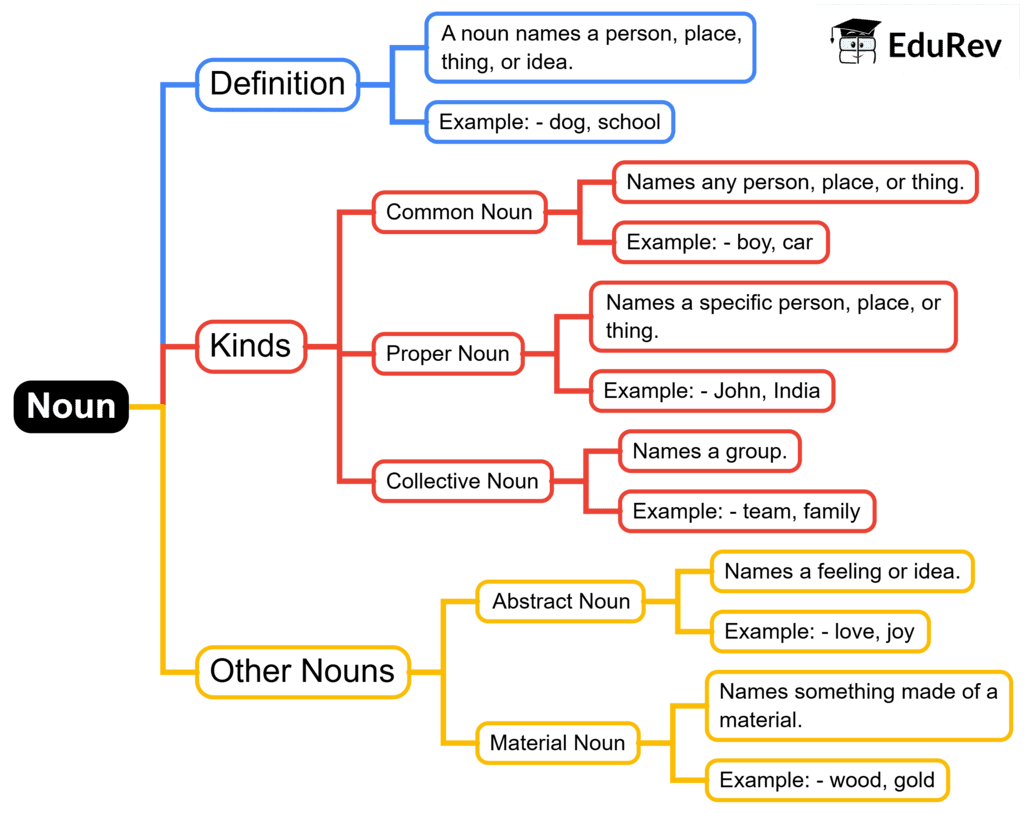Class 5 Exam > Class 5 Notes > English Grammar Class 5 > Mind Map: The Noun & Its Kind
Mind Map: The Noun & Its Kind | English Grammar Class 5 PDF Download

The document Mind Map: The Noun & Its Kind | English Grammar Class 5 is a part of the Class 5 Course English Grammar Class 5.
All you need of Class 5 at this link: Class 5
|
37 videos|288 docs|53 tests
|
FAQs on Mind Map: The Noun & Its Kind - English Grammar Class 5
| 1. What are the different types of nouns? |  |
Ans. Nouns can be categorized into several types, including common nouns, proper nouns, abstract nouns, concrete nouns, collective nouns, and compound nouns. Common nouns refer to general items (e.g., 'dog', 'city'), while proper nouns name specific entities (e.g., 'Rover', 'New York'). Abstract nouns denote ideas or concepts (e.g., 'freedom', 'happiness'), and concrete nouns refer to tangible objects (e.g., 'apple', 'car'). Collective nouns represent groups (e.g., 'team', 'flock'), and compound nouns are formed by combining two or more words (e.g., 'toothpaste', 'mother-in-law').
| 2. How do you identify a noun in a sentence? |  |
Ans. To identify a noun in a sentence, look for words that represent people, places, things, or ideas. Nouns often answer questions like "who?" or "what?" For example, in the sentence "The cat sat on the mat," both "cat" and "mat" are nouns. Additionally, nouns can typically be preceded by articles (like 'a' or 'the') or adjectives (like 'big' or 'red'), which can also help in their identification.
| 3. What is the difference between a common noun and a proper noun? |  |
Ans. The main difference between a common noun and a proper noun lies in specificity. A common noun refers to general items or classes of items without any capitalization (e.g., 'city', 'teacher'), while a proper noun names a specific individual or entity and is always capitalized (e.g., 'London', 'Mr. Smith'). Proper nouns are unique identifiers, whereas common nouns are more generic.
| 4. Can nouns be used in different grammatical roles within a sentence? |  |
Ans. Yes, nouns can serve various grammatical roles in a sentence, including the subject, object, and complement. For instance, in the sentence "The dog barked," "dog" is the subject noun. In "I saw the dog," "dog" acts as the object noun. Additionally, in "The winner is Jenna," "Jenna" functions as a subject complement noun, providing more information about the subject.
| 5. What are collective nouns, and can you provide examples? |  |
Ans. Collective nouns refer to a group of individuals or things considered as a single unit. Examples of collective nouns include 'team' (a group of players), 'flock' (a group of birds), 'class' (a group of students), and 'herd' (a group of cattle). These nouns are unique in that they denote multiple entities but are treated as singular in terms of grammar, such as "The team is winning" rather than "The team are winning."
Related Searches





















